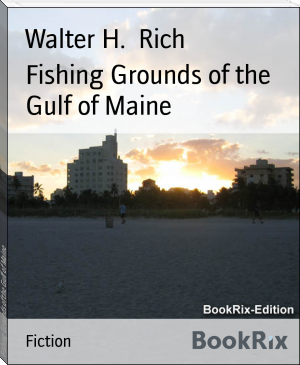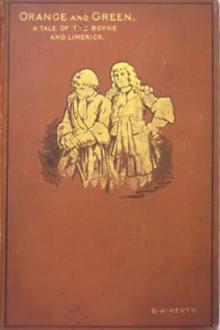Fishing Grounds of the Gulf of Maine, Walter H. Rich [readnow txt] 📗

- Author: Walter H. Rich
Book online «Fishing Grounds of the Gulf of Maine, Walter H. Rich [readnow txt] 📗». Author Walter H. Rich
"The Ridges" says the report before mentioned, "were for a number of years one of the favorite resorts for halibut catchers in winter, and many good catches of cod were taken here at that season. At present but few halibut are caught except in the deep water along the southern edge of the ground, where they sometimes have been found quite plentiful during nearly the entire year." Apparently there has not been much change in these conditions since the writer's time; fish seem to be present here In about the same quantities as in former years.
One piece of bottom, having depths of 25 to 50 fathoms over red clay, lying approximately in 43° 08' to 43° 10' north latitude and about 81° to 83° west longitude, seems a good spring and early summer ground. Apparently red-clay bottom indicates a good halibut ground, as this species is usually present where such a bottom is found.
Hake are found in good numbers in the deep water about the edges of the ground and even on the Ridges.
These waters are quite heavily fished from Canadian ports, and a fair number of American vessels visit them each year, most of them hailing from Boston or Gloucester.
Scandinavian Bank. Eighteen miles SSW. from Shelbourne Light. Nova Scotia. It is about 3 miles long in an E. and W. direction by about ½ mile wide. In general, the bottom is level, with depths from 50 to 70 fathoms; the shoal parts are sharp and rocky, the bottom over the deeper portions being composed mostly of small black and yellow pebbles.
This is a summer halibut ground (July and August) in depths from 45 to 60 fathoms, and halibut occur in October in the deeper waters about it. It is also a fair summer cod ground, and cusk are present in the deep water about the edges during most of the year. In general, species and seasons are much as on Roseway.
Western Bank. This is one of the most important fishing grounds of the western Atlantic, whether as regards size or the abundance of its product. It lies S. of Cape Breton Island and the eastern part of Nova Scotia between the parallels of 42° 55' and 44° 46' north latitude and the meridians of 59°04' and 62° 35' west longitude. It has a length of 156 miles and a width, including the Middle Ground, of 76 miles. It is about 420 miles E. ½ S. from Boston to the southwestern edge, which means about 48 hours' steaming for the otter-trawl fleet.
The general contour of the bank within the 65-fathom line, as laid down on the Admiralty chart, approaches somewhat a very elongated ellipse, the longer axis running NE. by E. and SW. by W.; but over a broad area to eastward of the center of the bank, soundings of less than 50 fathoms connect it directly with the Middle Ground, which we have here included in the some bank. The total extent of the bank thus defined is about 7,000 square geographical miles. Off its eastern end lies Banquereau (the Quereau of the fishermen) with The Gully between, and a short distance of the western edge are the La Have Ridges.
The depths off the southern edge of the bank increase rapidly from 80 to 700, 1,200, and even 1,400 fathoms. At the eastern end is Sable Island, [16] "graveyard of ships", a long, narrow, crescent-shaped elevation seemingly lessening in area each year, formed entirely of sand that has been blown Into innumerable hummocks and dunes. Off both ends of the island are long and dangerous sand bars. The length of the island is 20 miles; its greatest width is about 1½ miles. It is said that the Northwest Light has been moved three times due to the fact that the western end of the island has been literally blown away. It lies in an E. and W. direction, and the depth of water over the bars for a distance of 7 to 10 miles out does not exceed 2 fathoms, and even 10 miles farther out the depths do not exceed 10 to 11 fathoms. Within recent years fishermen have reported the appearance of a sand shoal about 5 or 6 miles SE. from the Northeast Light. This is said to appear at low water.
In general, the bank slopes S. and W. from the island, depths ranging from 18 to 60 fathoms. The bottom is mostly sandy with patches of gravel and pebbles. Currents are sometimes very strong about Sable Island and are somewhat irregular; apparently they are much influenced by the winds. On the other parts of the bank usually there is but little current, whatever there is usually tending toward the west.
Formerly the cod and halibut were the food fishes most taken here, but with the changed methods in the fishery (as the growth of the otter-trawl fleet) and a changed taste in our public the haddock catch has become the second most important in the receipts of fish from these waters. The halibut fishery stands third in the list. Other bottom feeders occur in less numbers, the pollock and the cusk perhaps being next in order of importance, with hake and a considerable amount of the various flatfishes in the otter trawls. These latter are marketed as sole.
Noting the small amount of haddock in the fares taken from these waters in former years, the writer asked a number of old-time fishermen as to its abundance in the old days. The reply was usually "Oh, yes, there were always haddock there; sometimes they bothered us a lot." Then, noting my surprise at so putting it, "You know, the haddock isn't much as a salt fish."
It will be noted that in 1923 the haddock catch here was a very good second to the cod catch in poundage, though not so valuable proportionately. In the otter-trawl catch from this ground it will be noted that the positions of the two species are reversed. As a rule, these steamers certainly take more than 2 pounds of haddock to 1 of cod on other offshore grounds--perhaps the result of operating in the shoaler waters and on the smoother bottom because of the difficulty of dragging over the rocky and kelp-covered ground, which the cod seems to prefer. But the bottom on the Western Bank is of such nature as to offer little obstruction to the passage of the net, so that virtually all parts of it may be fished by this method; and this, added to the known movements of the cod schools makes it possible at certain seasons of the year to catch a larger proportion of this species if it is so desired.
Haddock are found about the bars at both ends of the island in March and from that time to about June 1 in from 15 to 22 fathoms. They are also abundant 18 miles W. from the Northwest Light at the same seasons and at the same depths. During April, May, and June they come in close to the island in from 10 to 17 fathoms--even to 1 fathom. Through the rest of the year (except for the colder months, when they have moved off into deeper water) they may be found all over the bank on sandy bottom in 28 to 30 fathoms, where most of the beam trawl fishing is carried on.
There is a good cod school each year on the comparatively level bottom along the western and southwestern edges of the ground in 70 fathoms and more from February 1 to May 1, and in most years a certain amount of this species is taken on this area. In May this school seems to have moved on to a piece of bottom about 20 miles long lying SW. from the Northwest Light and having depths averaging 27 fathoms. With fair fishing for cod on the Western Bank during most of the year, they seem to be most abundant from the first of March to June. The winter school here appears to be smaller than that on Georges, but apparently this species visits this ground in considerable numbers during the spawning season. In winter the cod are mainly found upon the western part of the bank, moving into the shoaler waters toward Sable Island as the spring advances (during March and April), the "Bend" of the island and the neighborhood of the bars in 2 to 4 fathoms, where they can be seen taking the hook or can be "jigged." being favorite grounds. The ground lying W. from the Northwest Light, on and about the Northwest Bar (18 miles W, from the light), is a favorite cod ground in May and June. The shoal water over the rocky bottom WNW from the Northwest Light furnishes good cod fishing from June 10 to July 1. This piece begins just outside the 3-mile stretch of breakers running out from the land and extends offshore in a generally westerly direction to 24 fathoms. Much hand-lining is done here.
In the shoal water, in April and May, the fish seem to be feeding on the "lant," (Ammodytes americanus). It is said that the fish taken on the bottom close to the island are smaller than those found farther west. The shoal water of the northern shore of the island is said to have good cod grounds and favorite spots for "dory hand-lining." The cod schools seem to arrive on the Northern Peak (SE. from the Northeast Light 40 miles to SE ½ S. from same point 28 miles) in late March and the first of April, moving N. and W. to the island. The cod of Sable Island are said to be fine, firm fish, perhaps due to the abundance of the "red clams" (bank clams) on these grounds.
The cod and haddock fishery is carried on by American and Canadian sailing vessels and otter trawlers, an increasing number of English and French vessels of the latter class engaging in the fishery of this ground each year.
Halibut are found on the Western Bank virtually all the year at depths varying with the seasons. As a halibut bank, this, with The Gully and Quereau--in fact, all one piece of ground--ranks second only to the Grand Bank Itself. The best fishing here for halibut is found from January to October. There are numerous places on and about the bank that the halibut seems to prefer, as the Peak of Pike, 85 miles W. by S. from the Northwest Light of Sable Island; S. and SW. of Sable Island from 12 to 38 miles; SW. 20 miles in 60 fathoms in May; thence out into 100 and 150 fathoms in June; in fact, following the 100--fathom curve along the edge of this bank, past the Northeast Peak (40 miles SE. from the Northeast Light), into the Gully and around the Southern Prong of Quereau to the Middle Prong. Apparently they leave this piece of bottom in July. Often the fish are close to the island in the spring, where the water is so shoal that they can be seen taking the bait or playing with the hook before taking. In April, May, and June a good halibut ground is in 18 fathoms 24 miles WNW. from Sable Island.
The Western Bank seems to be a good feeding ground for both cod and halibut as it abounds in shellfish and crustaceans, and at certain periods there are many smaller species of fish upon it, such as the lant and herring, on which these species and the haddock, also, especially prey. A considerable amount of swordfish is taken here in August and September, mainly by American vessels.
Banquereau. Separated from the Western Bank by The Gully, this has a very irregular form--the main bank roughly rectangular, with a narrow westerly extension of comparatively regular form. Its length, E. and W., is about 120 miles, its greatest width about 47 miles, and its total area about 2,800 miles.
The main portion of the bank lies between 44° 04' and





Comments (0)